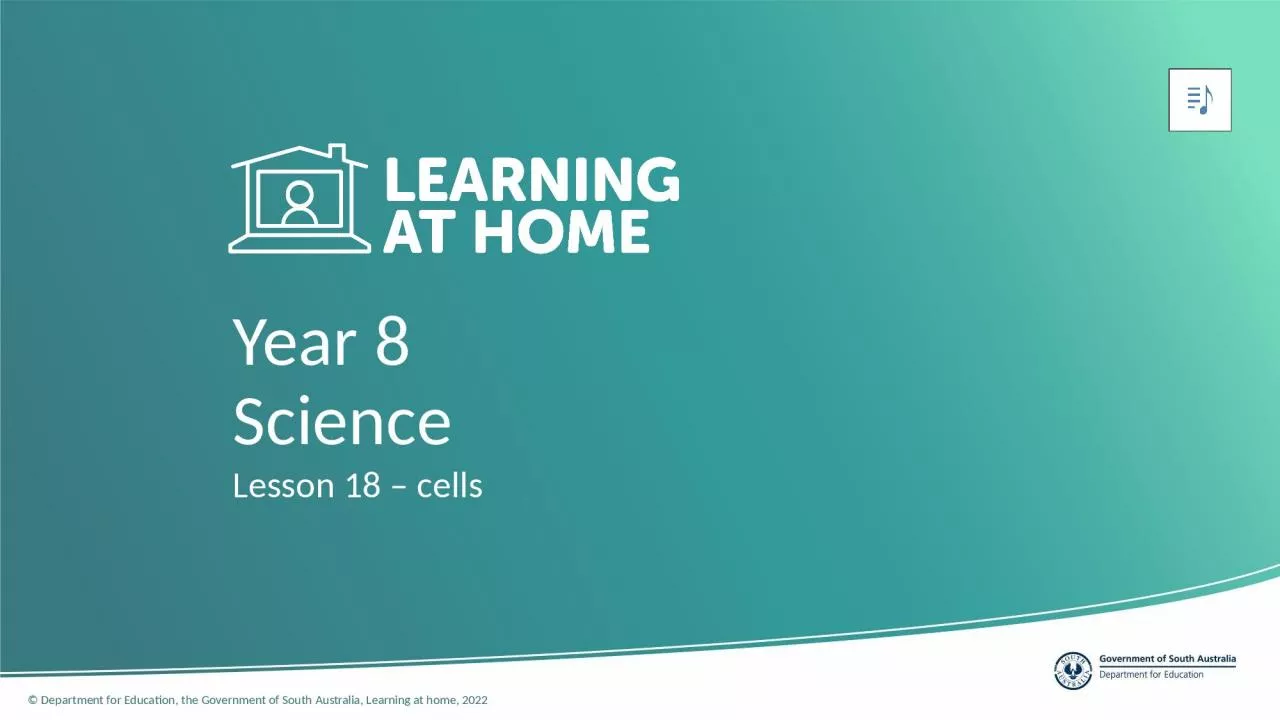

Science Learning intention To know and understand how organisms reproduce asexually by the process called mitosis You will need A pen and paper A digital device Lesson 17 challenge answers ID: 1042290
Download Presentation The PPT/PDF document "Year 8 Lesson 18 – cells" is the property of its rightful owner. Permission is granted to download and print the materials on this web site for personal, non-commercial use only, and to display it on your personal computer provided you do not modify the materials and that you retain all copyright notices contained in the materials. By downloading content from our website, you accept the terms of this agreement.
1. Year 8Lesson 18 – cellsScience
2.
3. Learning intentionTo know and understand how organisms reproduce asexually by the process called mitosis.
4. You will needA pen and paper.A digital device.
5. Lesson 17: challenge answersPlant nurseries and agriculture have been working with scientists to develop new techniques for propagating large numbers of plants using their understanding of asexual reproduction.ExamplesCloning: Humans have been cloning plants for centuries by taking cuttings, but modern science can alter the plants by modifying their DNA to produce plants that can withstand unfavourable conditions, such as poor soil nutrients.Tissue cultures: Another way of cloning plants is by tissue culture, also called micropropagation. It works with small pieces of plants, called explants. These are grown in vitro using sterile agar jelly that contains plant hormones and nutrients. This makes tissue culture more expensive and difficult to do than taking cuttings.
6. MitosisMitosis is a process of cell division. Cells divide when:an organism growsnew cells are produced to repair or replace cellsasexual reproduction occurs.It is essential that any new cells produced contain genetic information that is identical to the parent cell.
7. Process of cell divisionIn mitosis, 2 cells called daughter cells are produced, each identical to the parent cell.View the video to understand how the process of mitosis works.Mitosis and the Cell Cycle Animation on YouTube (Bioman Biology, 2020) For your safety, watch this video in the slideshow without accessing YouTube.
8. Mitosis worksheetComplete the worksheet questions on the stages of mitosis on the following slides. The answers will be after each stage. There is no audio on the worksheet slides.
9. Mitosis worksheetIdentify this phase of mitosis
10. AnswerProphase
11. Mitosis worksheetIdentify this phase of mitosis
12. AnswerAnaphase
13. Mitosis worksheetIdentify this phase of mitosis
14. AnswerTelophase
15. Mitosis worksheetIdentify this phase of mitosis
16. AnswerInterphase
17. Mitosis worksheetIdentify this phase of mitosis
18. AnswerMetaphase
19. Review (part 1)Mitosis is a process of cell division which has been divided into 5 phases.This type of cell division allows organisms to grow, replace damaged tissue and reproduce.
20. Interphase: Every time a cell divides, it must first replicate all of the chromosomes, which are made of DNA. Prophase: The 2 sister chromatids for each duplicated chromosome become visible. Metaphase: The chromosomes align at the centre of the cell and are attached to the spindle fibres.Anaphase: Sister chromatids separate and move toward the corresponding poles.Review (part 2)
21. Review (part 3) Telophase: Daughter chromosomes arrive at the poles. The nuclear membrane envelops around the chromosomes. The cytoplasm divides, the cell membrane pinches inward producing 2 daughter cells (phase: cytokinesis).
22. ChallengeCells acrostic poemAn acrostic poem is one where you choose a word or name and use each letter in the name as the beginning of a word or line that tells something about that person or topic.Example: An acrostic poem using the word "Sun."Sometimes when we go to the beach, I will get sunburn.Usually if I put sun block on my skin, I will not burn.Noon is when I'm really prone to burning.Write an acrostic poem using the word below.CELLS
23. Key termsChromosomes are threadlike structures of DNA found in the nucleus of most living cells which carry genetic information in the form of genes.Chromatids are each of the 2 threadlike strands into which a chromosome divides longitudinally during cell division. Each contains a copy of the cell’s DNA.
24.
25.